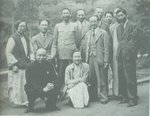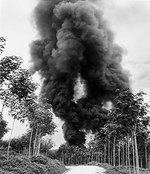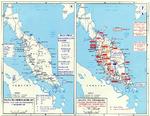
Malaya
| Full Name | 39 Federated and Unfederated Malay States | |
| Alliance | Allies - Minor Member Nation or Possession | |
| Possessing Power | United Kingdom | |
| Entry into WW2 | 8 Dec 1941 | |
| Population in 1939 | 4,000,000 | |
| Civilian Deaths in WW2 | 60,000 |
Contributor: C. Peter Chen
ww2dbaseThe Federated Malay States, established in 1895 and formally signed into treaty in 1896, was a British protectorate consisted of the states of Selangor, Perak, Negeri Sembilan, and Pahang. Its capital was Kuala Lumpur. Although each of the constituent states were given autonomy in terms of domestic affairs, by treaty they were bound to follow orders given by the British resident of each state. Each of the residents in turn reported to the Federal Secretary of the Federated Malay States. The two most important products of the protectorate were rubber and tin. Rubber plantations were found throughout all four states, while tin was primarily mined in the Klang valley in Selangor and the Kinta valley in Perak. The British colonial administration brought in many southern Indians to work on the rubber plantations and many southern Chinese to work in the tin mines. Due to the profitability of the two materials, reasonable amounts of revenue were re-invested locally in the form of roads, rail system, and schools.
ww2dbaseThe Unfederated Malay States were administered separately. It was consisted of the states of Johor, Kedah, Kelantan, Perlis, and Terengganu; each in name was a separate British protectorate. A British advisor was installed to oversee each of the states. Rubber was an important product from these states, similar to the Federated Malay States.
ww2dbaseIn the years leading to the start of the Pacific War, the various Malay States produced about 40% of the entire world's output of rubber, which made these territories attractive to expansionist Japan, which, with a rapidly growing military, had a great hunger for rubber. WW2 began for the Malay states on 8 Dec 1941, about 90 minutes before the Japanese struck the US military installations at Pearl Harbor in the Territory of Hawaii. Japanese and Thai troops crossed the border and marched into Perlis, Perak, and Kelantan. The conquest was rapid, despite the fact that the Japanese Army's jungle training program (located in Taiwan) was only in its infancy, having been created in Dec 1940. The capital of the Federated Malay States, Kuala Lumpur, along with its large stores of food, fuel, and ammunition, was captured in mid-Jan 1942. Gordon Bennett and his Australian 8th Division staged several ambushes against Japanese troops, while successful in causing casualties, they largely did not significantly slow the Japanese advance. Blown bridges, however, slowed the momentum, but the Japanese was still able to reach as far south as Gemas on 15 Jan and Johor by the end of the month. By the time the Japanese troops neared the border with Singapore, the Japanese had suffered 5,000 casualties (2,000 killed), while the British lost the equivalent of two divisions worth of men (casualties and captured).
ww2dbaseThe Japanese occupation came in the form of a military government oversaw by generals of the Japanese Army. The 25th Army's Chief of General Affairs Department Colonel Wataru Watanabe was largely the man responsible for carrying out the day-to-day orders over the conquered territory in its early days. He gave local sultans limited self-rule. While oppression was placed universally upon all three of the major ethnic groups in Malaya, ethnic Malays and ethnic Indians were not treated as harshly as the ethnic Chinese, as the Chinese in Malaya and Singapore had a history of contributing great amounts of monetary funding toward Chinese war efforts against Japan. Thousands of ethnic Chinese civilians were massacred, with most of the atrocities taking place in Mar 1942 during the sook ching ethnic cleansing. In Mar 1943, Watanabe was replaced by Major General Masuzo Fujimura. In Mar 1944, Colonel Hiroshi Hamada succeeded Fujimura. Fujimura and Hamada implemented friendly policies toward the locals; Hamada even established official relationships with Chinese community leaders and youth groups. The occupation administration in general sought to assimilate the locals. To that end, the time zone was changed to align with Japan, the Japanese language was made the official language, and Japanese social customs such as bowing became required when local civilians encountered Japanese nationals. To control information, all newspapers were combined into a new company, Penang Shinbun, which was run as a subsidiary of the Japanese news agency Domei Tsushin. During the occupation, rubber production fell significantly. Allied blockade, particularly toward the later parts of the war, further reduced Malaya's usefulness to Japan.
ww2dbaseFrom the start of the occupation until Jan 1944, the Japanese 25th Army, with its headquarters in Singapore, was the garrison force of Malaya. Between Jan 1944 and the end of the war, the defense of Malaya fell under the responsibility of the 94th Infantry Division (Lieutenant General Teizo Ishiguro) of 29th Army, with its headquarters in Taiping, Perak. The 2nd Field Kempeitai (Lieutenant Colonel Oishi Masayuki; pre-Jan 1944) and 3rd Field Kempeitai (Major General Masanori Kojima; post-Jan 1944) provided additional support for maintaining order.
ww2dbaseIn Jan 1943, Japan ceded the northern states of Kedah, Perlis, Kelantan, and Terengganu to Thailand. They were administered as Thai provinces of Syburi, Palit, Kalantan, and Trangkanu until the end of the war.
ww2dbaseIn the early days of the occupation, the British government supported the Malayan Communist Party as the main resistance movement against Japan. A small number were trained by the British in Singapore before Singapore's capture. In Mar 1942, various communist resistance cells in Johor were unified under the name of Malayan Peoples' Anti-Japanese Army. In Sep 1942, more than 100 leaders of the communist party who had gathered for a meeting north of Kuala Lumpur were attacked by the Japanese, resulting in the death of most of the attendees and a significant decrease in Malayan Peoples' Anti-Japanese Army activity for a long period of time. In 1944, Malayan Peoples' Anti-Japanese Army leadership agreed to accept some direction from the Allied South East Asia Command in exchange for weapons and supplies, which would arrive beginning in the spring of 1945. A separate resistance movement, Pahang Wataniah under the leadership of Yeop Mahidin, was concerned with both resisting the Japanese occupation as well as secretly protecting the Sultan Abu Bakar of Pahang from assassins sent by the Malayan communists.
ww2dbaseAllied attack on Japanese occupied Malaya came quickly. On 2 Feb 1942, Dutch East Indies based US B-17 bombers attacked airfields at Kuantan and Kuala Lumpur. However, this attack would prove to be the only raid until early 1945 when US 20th Air Force began striking airfields and rail yards in Kuala Lumpur and other locations in Malaya.
ww2dbaseAfter the war, communist movements were banned despite of their anti-Japanese efforts during the war. The Pahang Wataniah was reorganized as a territorial force named Rejimen Askar Wataniah.
ww2dbaseOn 1 Apr 1946, the British formed the British Military Administration to govern the entire Malayan Peninsula, less Singapore, as a unified body. The Malaya Union was renamed the Federation of Malaya in 1948. On 31 Aug 1957, the federation gained independence. On 16 Sep 1963, the nation of Malaysia was formed, which included the Malay Peninsula, Singapore, Sarawak, and North Borneo. Singapore would be expelled from Malaysia two years later due to racial and political tensions, forming an independent city state.
ww2dbaseSources:
William Manchester, American Caesar
Wikipedia
Last Major Update: Jan 2018
| People | ||
| Adnan | Kathigasu, Sybil | |
| Chin, Peng | Tunku Osman | |
| Events Taken Place in Malaya | ||
| Invasion of Malaya and Singapore | 8 Dec 1941 - 15 Feb 1942 | |
| Japan's Surrender | 14 Aug 1945 - 2 Sep 1945 | |
Photographs
 |  |  |  |
 |
Malaya in World War II Interactive Map
Please consider supporting us on Patreon. Even $1 per month will go a long way! Thank you. Please help us spread the word: Stay updated with WW2DB: |
Visitor Submitted Comments
14 Aug 2010 04:34:36 PM
searching for my grand father he was in malaya 1946 and have my mother don,t what happen to him he died or alive never see ,he was in kuala lumpur i am sure he is not are post man or dispatch man but i thing he was with motorcycle around kuala lumpur something do with transport or services
16 Oct 2010 10:41:29 PM
searching for my grand father in malaya 1945 to 1947 operation zipper in malaya he was in british militry as mail man or post man or dispatch man to the serounding militry camp around kuala lumpur the only thing we know is his name was peter part soilder and part mail man
8 Oct 2018 07:02:30 AM
looking for any info for mr ford ... my grandfather who was here in malaysia kuala pilah during world war 2 . really want to find out my family roots from his side . i got some small info that he is returning to his country after the war . no idea about his post .
8 Jan 2020 10:00:40 AM
Hi I am looking for information about my grandfather who went missing in Jahore in 1942. He was a local lawyer and business man and his name was Toh Gim Hann of G.H. Toh. Can anyone help me find records or suggest who can help me. This is very important to me and any help would be appreciated. Thank you
All visitor submitted comments are opinions of those making the submissions and do not reflect views of WW2DB.

- » Wreck of Teruzuki Found (27 Jul 2025)
- » USS Orlean's Bow Found (22 Jul 2025)
- » The Emperor of Japan Planned to Honor WW2-era Japanese POWs in Mongolia (4 Jul 2025)
- » US State Lawmaker John Winter Caught Using Racial Slur "Jap" and Apologized (11 Jun 2025)
- » US Government Plans to Purge WW2 Information (17 Mar 2025)
- » See all news
- » 1,182 biographies
- » 337 events
- » 45,115 timeline entries
- » 1,248 ships
- » 350 aircraft models
- » 207 vehicle models
- » 376 weapon models
- » 123 historical documents
- » 261 facilities
- » 470 book reviews
- » 28,414 photos
- » 365 maps
Winston Churchill
Please consider supporting us on Patreon. Even $1 a month will go a long way. Thank you!
Or, please support us by purchasing some WW2DB merchandise at TeeSpring, Thank you!
10 Jul 2010 11:44:30 PM
appriate the soldier who had died , may they died in peace